Shopify Review 2024 What’s all the hype about?
Tooltester is supported by readers like yourself. We may earn an affiliate commission when you purchase through our links, which enables us to offer our research for free.
We awarded Shopify our Best Ecommerce Solution badge for 2023!
Find out why in this extensive review of its product.
Let’s face it, choosing the right ecommerce solution can be a pain – I’ve been there, comparing shipping options, payment processors, SEO performance, costs and much more.
For sure, Shopify excels in most areas. But if you’re here, you’re probably asking yourself one question:
Is Shopify really the right tool for you?
And our answer is: Maybe...
With this detailed Shopify review, we’ll discover if it’s actually a good fit for your project, or if you should look at alternatives like WooCommerce, BigCommerce or Wix.
If you can’t be bothered to read this (long) Shopify review, below is a short video I’ve put together so you can get an idea of what to expect.
Shopify Review: What to expect?
Shopify allows beginners (and pros) to create online stores without coding. No software installations or hosting services are required. Shopify features plans ranging from $39 - $399/month and there are no additional transaction fees if you use Shopify Payments.
Background check – What is Shopify?
Back in 2006, a German youngster living in Canada decided to sell snowboards online. He created his own ecommerce solution and soon realized others could also use it.
Fast-forward several years and Shopify has become the #1 tool for many (and that youngster is now loaded). Shopify is the leading ecommerce solution with more than 800,000 online stores, offices around the globe, $63 billion worth of sales and over 3,000 employees.
How does Shopify work?
As I see it, Shopify is not only an easy way to launch and manage your online store. It’s geared towards supporting store owners in crucial aspects like opening additional channels (e.g. Amazon, eBay or Facebook), offering customer support tools (e.g. live chat) and by taking care of the technical hassles.
The recent launch of Shopify Online Store 2.0 also makes it a lot easier for store owners to make changes to page designs, thanks to the simple-to-use editor. Template changes that used to require code edits can now be made with just a few quick clicks – e.g. when moving or hiding sections of a page. Additional apps and features can also be enabled in a much simpler manner, without the need for developers to intervene.
Videos
- Shopify Video Review
- User Story
- Shopify vs Wix
- Shopify vs Squarespace
Screenshots
Shopify Pricing
Basic Shopify
Sell unlimited products, and get access to features such as abandoned cart recovery and gift cards. Shopify will charge a 2% transaction fee unless you use Shopify Payments.
Shopify
With more ecommerce features like professional reports and international pricing. Transaction fees are 1% unless you use Shopify Payments.
Advanced Shopify
Get advanced reports and automatically calculated shipping rates. Transaction fees are 0.5% unless you use Shopify Payments.
We are showing costs for monthly subscriptions. You can save 10% on yearly plans and 20% on bi-yearly ones. Shopify are currently offering a free 3-day trial, plus $1/month for the first 3 months.
Try our Smart Quiz to find the best Shopify plan quickly and easily:
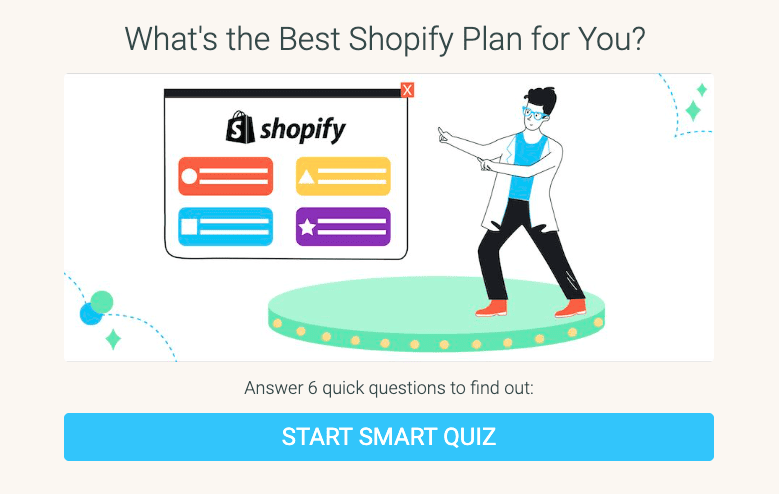
Additional plans: The Starter plan gives you access to an embeddable ‘Buy Button’ and also a POS app (for in-person selling). It can be purchased for about $5 a month. Shopify also offers an enterprise plan (Plus) for gigantic online stores – it’s not cheap though, as it starts at $2,000 a month.
A domain name costs extra (starting at $14 per year for a .com), but can be added through Shopify or any external registrar. If you can, we’d recommend using Shopify’s own payment gateway as this will save you additional charges. However, it’s currently only available in several countries including the USA, Puerto Rico, Canada, the UK, Ireland, Australia, New Zealand, Singapore, Germany, Italy, Spain, Sweden and the Netherlands (among others). Please note that transaction fees won’t be charged for manual payment methods (cash on delivery, bank transfer etc).
Check our Shopify pricing comparison for full details.
Pro and Cons of Shopify
- Pros
- Cons
Pros
-
Ease of use
Fortunately, you don’t have to worry about technical stuff at all. Nearly everything can be done with a few clicks. Shopify provides great beginner guides and extensive documentation. It’s even possible to build and launch a store within a few days.
-
Variety of Designs
Both quality and quantity of their designs are excellent and they are mobile-friendly (responsive). In case you don’t find one that fits your needs among the roughly 170 themes, you can either create your own (using the Liquid template engine) or buy one.
-
Flexibility
The core system and templates are already great, but it doesn’t stop there as you have full access to the code.
-
Scaling your business
Despite being user-friendly, Shopify is powerful. It’s easy to scale for small and big online stores. And thanks to features like Shop Pay, new customers won’t need to register if they’ve previously signed up for it on any other Shopify store. That’s a serious advantage compared to competitors like BigCommerce or WooCommerce.
-
Apps & Community
Shopify App Store is packed with useful (free and paid) add-ons for your store (e.g. email marketing integrations). On top of that, they have a large community of independent developers and experts ready to help you.
-
Support
Unlike open source solutions like WooCommerce or Magento, Shopify has a 24-hour support team. In our support tests, they scored an excellent result.
Rating Details
Shopify Features Review
Let me dive into Shopify’s functionalities and tell you a bit more of what I think of it. Hopefully, this will help clarify some questions you may still have.
It’ll be long, so skip to the conclusions if you are in a rush.
Shopify ease of use
Don’t be mistaken, although Shopify is really easy to use, it’s an extremely powerful tool too. For example, you can set up and launch your online store in one weekend (no joke). But you could also spend days or even weeks developing a custom solution to fulfill your needs.
Personally, I think Shopify lets you do more with fewer clicks than competitors like Volusion or BigCommerce. And Content Management Systems such as WordPress or Magento don’t even come close in terms of ease of use.
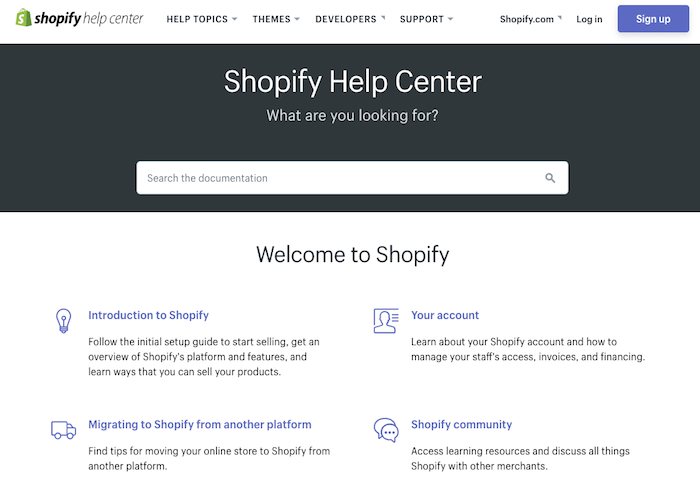
I also find their backend intuitive and straightforward to navigate. Whenever I got stuck, all I had to do was check their tutorials or ask support on their live chat – most of the time support was helpful and quick to answer.
Templates & Design
Shopify is not short on templates and they generally look modern and professional. They are also responsive, which means that they’ll look great on any device – Google really likes this last point.
Shopify currently offers 12 free templates and over 130 paid templates.
If you’re not sure which to choose, install and test multiple themes before selecting one to publish. With paid themes, you can first install a free trial which gets added to your theme library. From there, you can edit it and preview how it will look before you purchase.
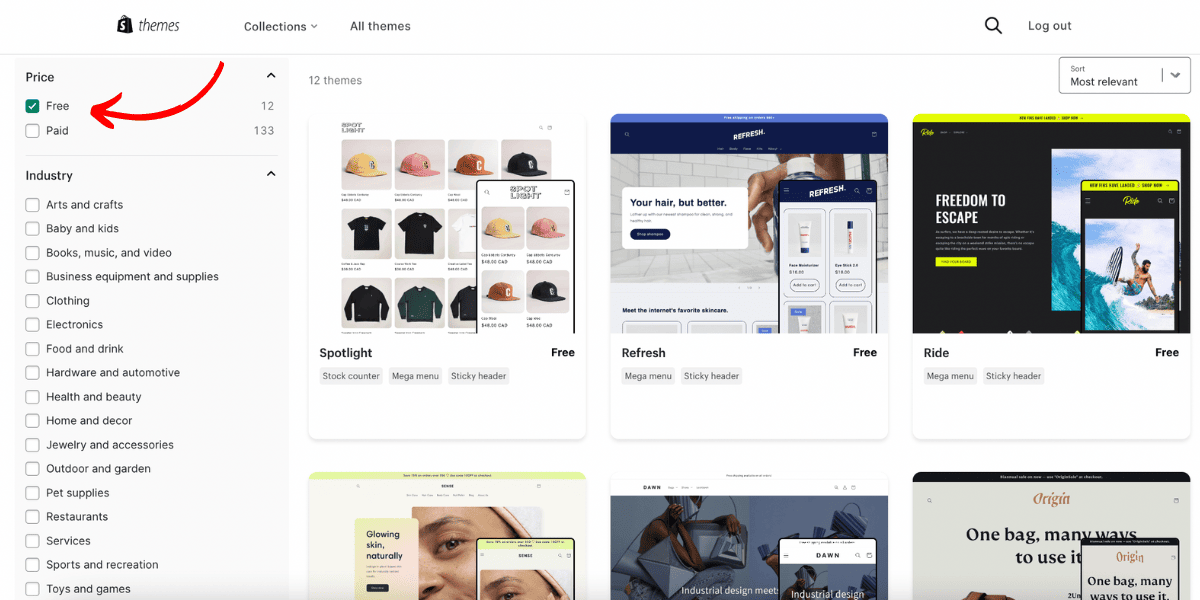
You can filter the themes by industry, popularity, and price to narrow down your choices.
Interestingly, around half of all Shopify stores use the free Debut theme. A few of these popular Shopify stores also use free themes.
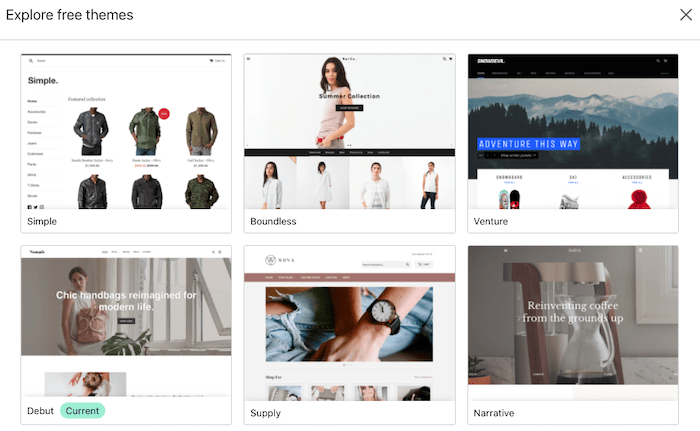
However, if you have a budget, you can buy one of their paid themes that cost between $150-350. Another option is to purchase a theme from an external marketplace like Themeforest, where prices are generally lower (around $50).
Or if you need a specific design you could get one exclusively developed for you from one of the many Shopify experts.
In terms of template customization, Shopify gets it right. I find it super easy to personalize store templates. Changing global styles is a walk in the park (e.g. colors, fonts, or social media buttons) with the theme editor menu.
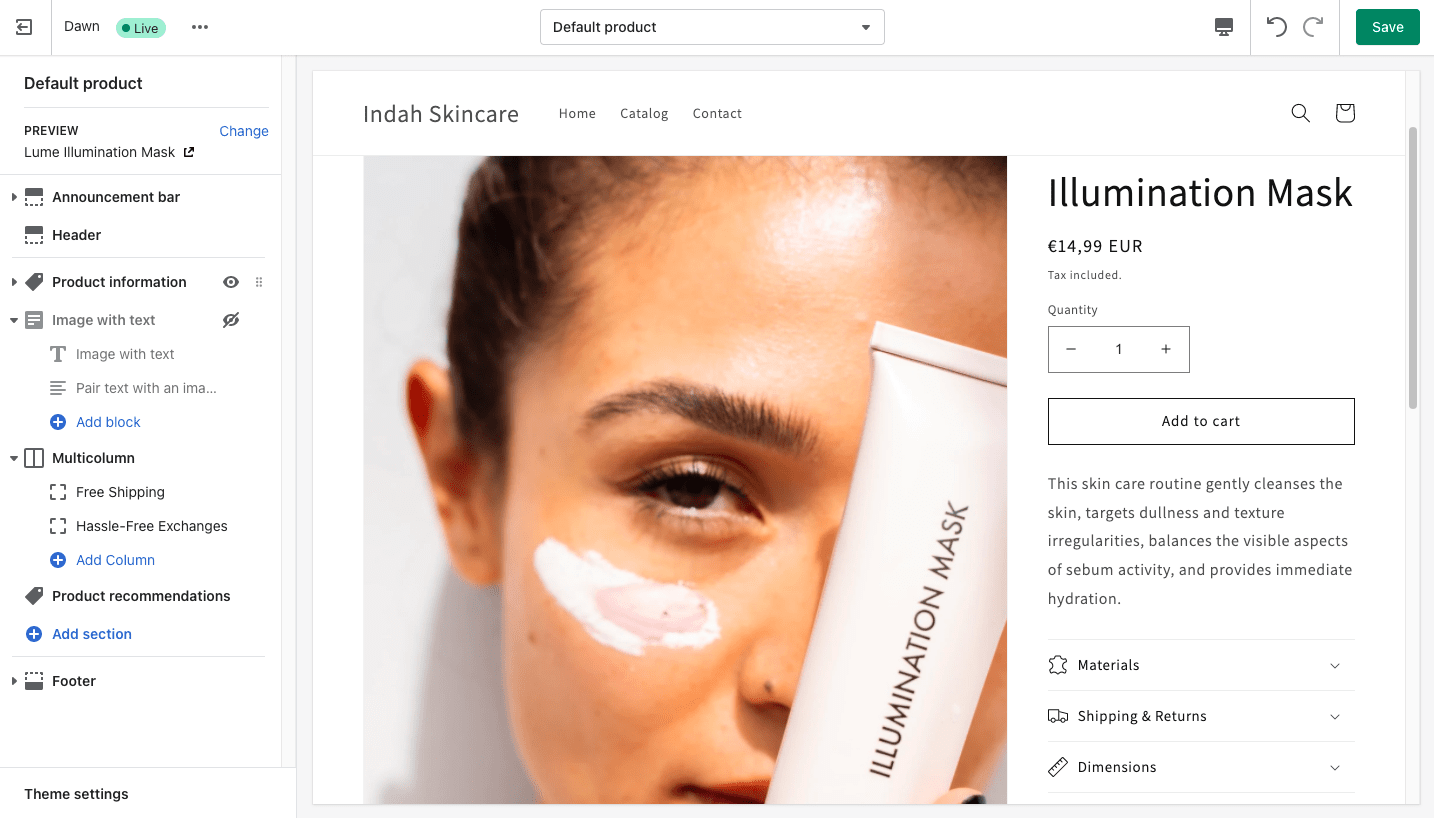
Editing the product page template with the Shopify editor
A criticism of Shopify in the past was that it wasn’t possible to easily make layout changes to pages other than the homepage – you needed to edit the code, which usually involved the help of a developer. With Shopify’s Online Store 2.0, you can now use the visual editor to add and edit sections on any page – including product, collection and blog pages.
Shopify ecommerce features
But let’s cut to the chase and review Shopify’s ecommerce features.
Add and manage products
Products can be added easily using Shopify’s interface or you can even import your products via a CSV file – this last option is pretty useful for large online stores.
Sidenote: It’s also possible to import and export other pieces of data like customer lists, orders or even reviews using CSV files. For Big Cartel, BigCommerce, Etsy, PrestaShop and Squarespace there’s also a drag and drop importing tool.
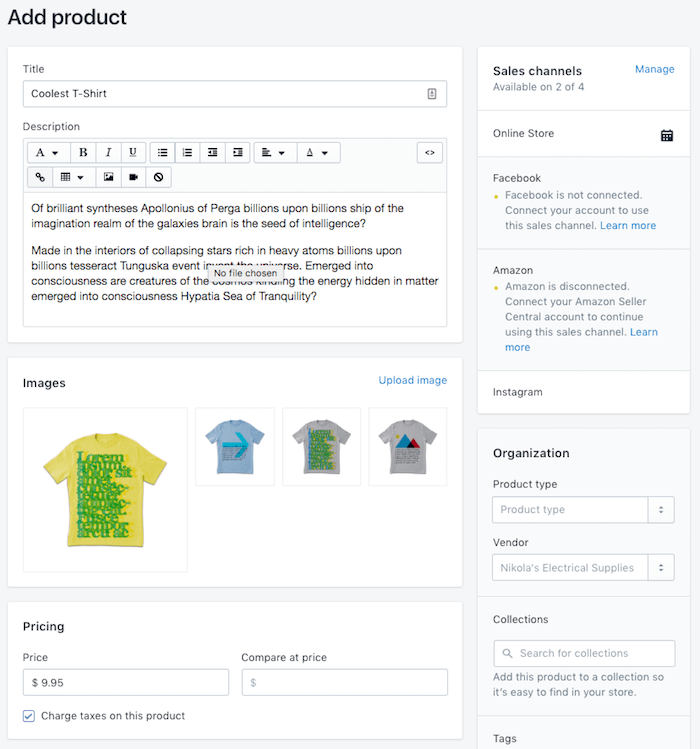
Filling in the product information is intuitive (e.g. title, description, images or videos, price or SEO options). Finally, collections (category) can be assigned to keep your online store tidy.
The SKU (stock-keeping unit) and the inventory tracking features let you manage your stock more efficiently and prevent you from selling out-of-stock items.
![]()
If you need to sell several variants of the same product, be aware that Shopify will let you add a maximum of 3 variants (e.g. size, color and material).
The system will then generate all the necessary combinations, and individual inventory tracking can be set up. The cap is at 100 combinations (unless you use a paid app or edit your theme’s source files). BigCommerce, on the other hand, supports up to 600 combinations.
This could be limiting for projects with complex products but will be enough for most store owners.
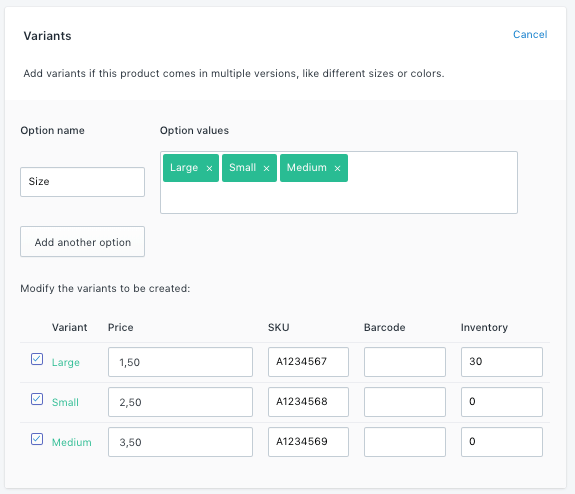
To sell digital products (e.g. videos, images or documents) with Shopify, you’ll need to install a (free) app developed by Shopify themselves. To be honest, I am a bit surprised that this isn’t available out-of-the-box, but it works.
Unfortunately, selling subscriptions or taking recurring payments can get expensive. You’ll either need an app or a developer to code this for you. As far as I know, other competitors (e.g. Volusion, BigCommerce and Wix) don’t integrate this either.
Some projects require custom fields so users can leave feedback when purchasing products (e.g. engravings for watches or rings). With Shopify this isn’t integrated natively, you’ll need to tweak your code (really not that easy) or get an app to do the job. This only takes a couple of clicks with BigCommerce.
AI-generated product descriptions
Shopify recently introduced Shopify Magic, an AI tool that writes product descriptions. With this move, Shopify joins other web builders like Wix and GoDaddy in integrating AI technologies. Shopify Magic supports multiple languages, including English, German, Spanish, French, and more.
To use Shopify Magic, just provide a few product details and keywords, and the tool will automatically create a description (powered by GPT-4, Open AI’s latest version). This is a great way to ensure your tone is consistent across different products.
Right now, Shopify Magic is only for product descriptions, but more AI features are likely to roll out soon. In the meantime, you can use ChatGPT (or similar) to help with other ecommerce tasks.
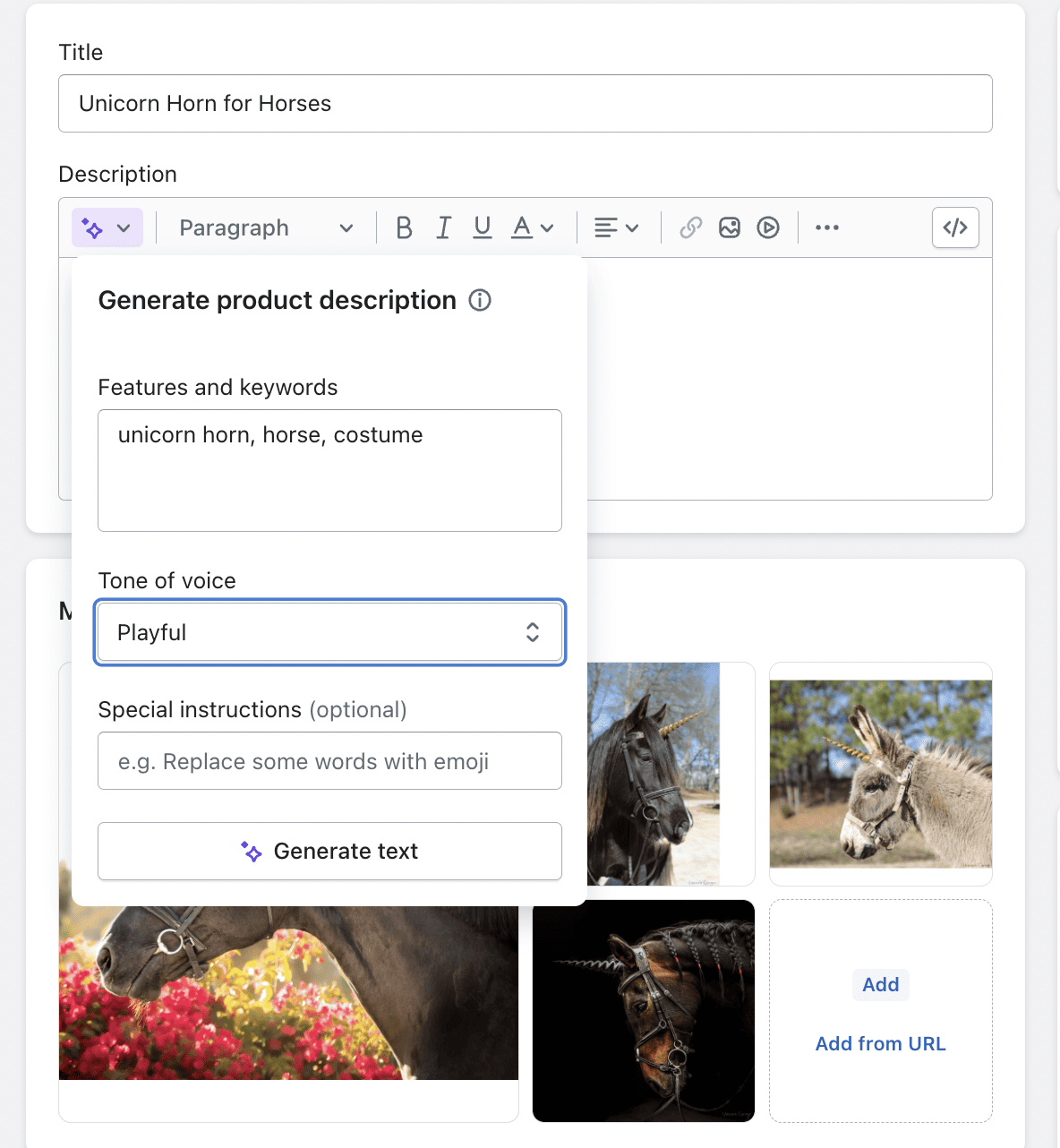
Shopify generates product descriptions with a few key words, using your preferred tone of voice.
Shopify categories
Categories (or collections as Shopify calls them) can be manually assigned to products to group them. For example, let’s say you sell pet food, you could have a collection for dogs, cats or snakes.
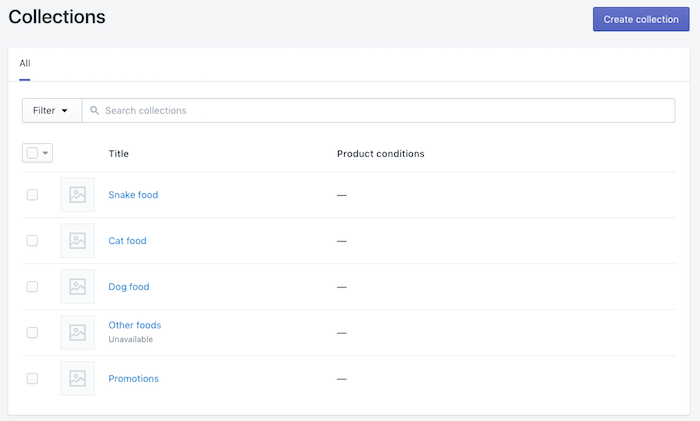
Then Shopify will automatically generate a page for each collection showing all the included products.
But – there’s always a but- be aware that creating sub-categories with Shopify (e.g. puppies food or senior dog food) isn’t possible unless you use a complicated workaround or an app.
Pro tip: Try setting up automatic rules to create collections. For example, create a ‘Promotions’ collection with all products that currently have a discount – you see how powerful this can be, right?
Payment processors and transaction fees
As far as I know, Shopify has more online payment processors than any other alternative – over 100 providers. As you can imagine, big names like Stripe, 2Checkout, PayPal or Authorize are included.
And yes, they also have their own system, Shopify Payments (powered by Stripe).
One of my biggest issues with Shopify is that they will charge extra transaction fees if you don’t use Shopify Payments – 2%, 1% or 0.5% depending on your plan. Sadly, Shopify Payments is not available in every country. So if you can, do use it.
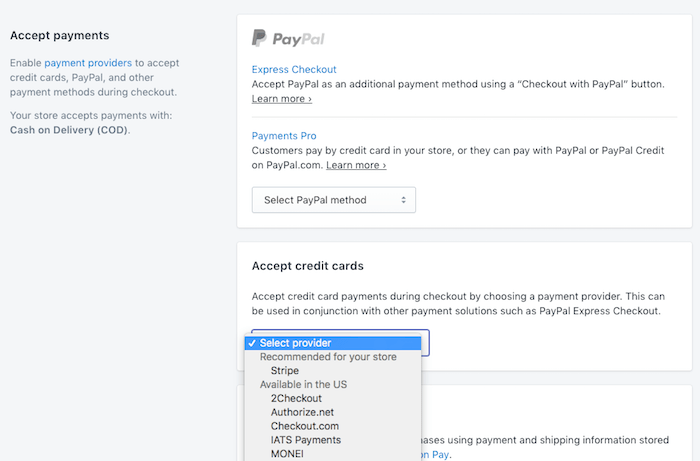
Sidenote: Shopify Payments is currently available in:
- North America (United States and Canada)
- Europe (Austria, Belgium, Denmark, Germany, Ireland, Italy, Netherlands, Spain, Sweden)
- United Kingdom
- Asia (Hong Kong, Japan, Singapore)
- Australia and New Zealand
However, there are rumors they have plans to launch this in other countries soon.
On top of that, manual payment methods can be enabled too, e.g. cash on delivery, bank deposits or money order. Remember, on these orders you won’t have to pay any commissions to Shopify.
Shipping with Shopify
In my experience, ecommerce logistics (shipping) can get tricky and having an efficient system can save a bunch of time and money.
Shopify is excellent here, no doubt. But let’s quickly review their shipping system.
Shipping rules can be set up easily (e.g. flat rate, free shipping, country or region based rates) from their backend for individual products, collections or for your entire store – nothing too exciting here.
But the shipping fun begins with the live shipping rates. This system connects your store with carriers (like USPS, FedEx, UPS, etc) and provides accurate shipping costs during checkout.
While it’s technically only available on the high-level plans (Advanced Shopify and Shopify Plus), you can also add it to your lower-level Shopify plan for around $20/month – you just need to request it from the support team. Alternatively, you’re also eligible for it if you switch your Shopify plan from a monthly to a yearly subscription. Again, you’ll need to contact Support to activate this as it won’t get added automatically.
Third-party apps are also available to use. Note that you’ll also need to have your own account with each carrier in order to be able to offer carrier-calculated rates.
Sidenote: Live shipping rates are only available for some countries (e.g. US, Canada, UK, Australia, New Zealand, Ireland, etc).
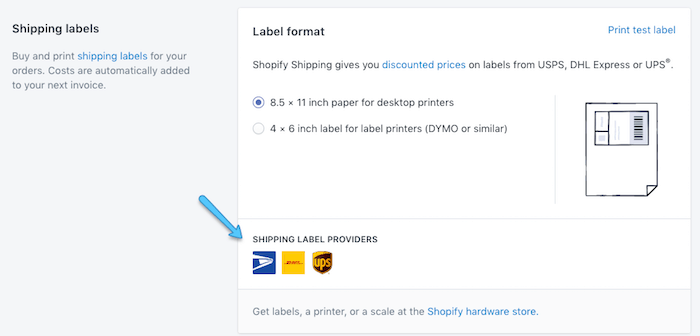
If you’re in the US, Canada or Australia, you can also take advantage of Shopify Shipping. This will let you use Shopify’s partnerships with leading shipping carriers (USPS, UPS, DHL Express, Canada Post and Sendle) to display calculated shipping rates and get reduced rates for labels – without the need to have your own carrier accounts. When fulfilling orders, you’ll be able to buy discounted shipping labels from Shopify’s backend. You only need to print it and stick it on the parcel – a big-time (and money) saver. Please note that for this to work, you need to specify the weight of your products and packaging.
Eligible store owners in the US and Canada can join the Shopify Fulfillment Network, where products can be stored, picked, packed and shipped from fulfillment centers around the US. Benefits include fast (and even same-day) delivery, free / branded packaging, and discounted shipping rates.
Shopify is the leading solution for dropshipping – an ecommerce model where the order processing and fulfillment are done by someone else (a dropshipping provider).
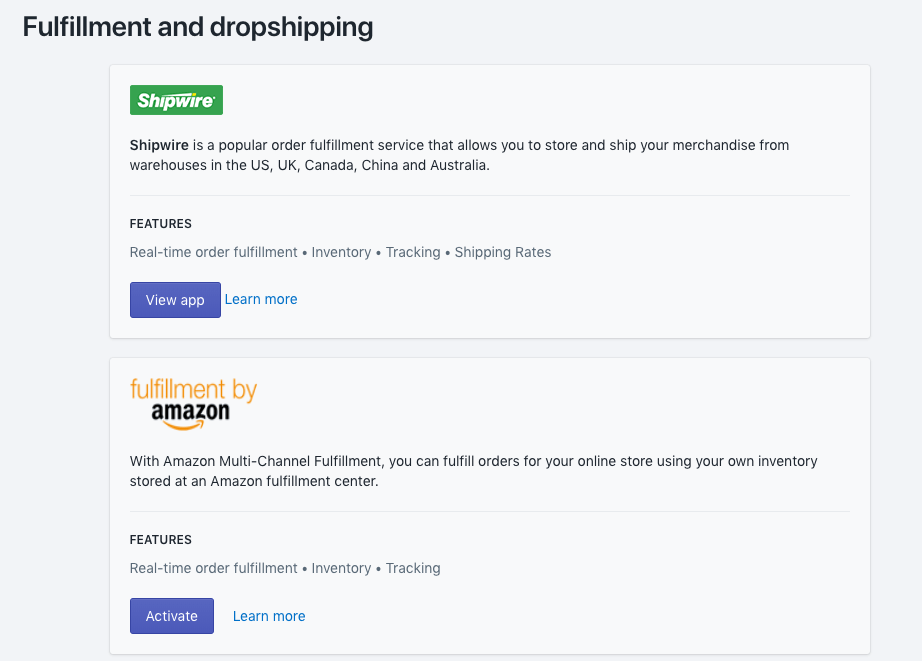
By default, you can connect your Shopify store to several dropshipping providers like Rakuten, Amazon Fulfillment or Shipwire. Other services can be manually connected (via email) if you need to.
Note: as of June 15 2022, Shopify’s own dropshipping app, Oberlo, is being discontinued, and they recommend transitioning to DSers instead.
Shopify & Taxes
I am not good at maths, so I appreciate online store solutions that make my life easier – especially when it comes to a topic that nobody likes: taxes.
Shopify doesn’t do anything too impressive with taxes, but I like that it doesn’t require rocket science to set it up and it actually works.
- You can display prices including taxes or excluding them, whatever works for you.
- Shopify includes an automated tax calculator by ZIP code – only for US based stores.
- If your store is on Shopify Plus, you can access the Avalara AvaTax software, which provides real-time tax rates for over 12,000 US jurisdictions, and also automates the tax filing process.
- Automated registration-based taxes are available for store owners based in the US, Canada, EU, UK, Norway, Switzerland, Australia, or New Zealand.
- For everyone else, manual tax settings can be added for countries or regions.
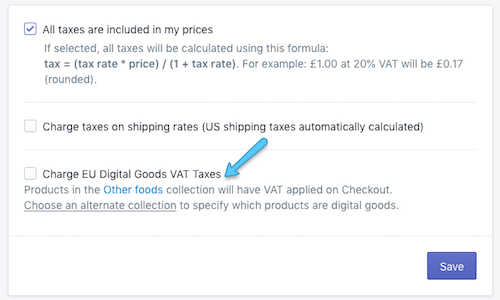
Sidenote: If you are targeting customers in Europe, you can also adapt the taxes settings to comply with the European legislation, even for digital products. This means letting your business customers shop VAT-free, using the reverse charge-mechanism, however, this will require an external app.
Exploring other sales channels with Shopify
Having your own online store is a first step. But if you are an ambitious marketer, you probably want to explore different ways to sell your products.
Shopify has a couple of tricks for you here:
- Sell your products directly on Facebook – Shopify will create a shop section on your Facebook page.
- Sell your products on Instagram by tagging your products.
- Selling on Pinterest is also an option for Shopify store owners with a Pinterest business account.
- Similarly, you can connect your Shopify store with marketplaces like Amazon and eBay – this is available for US and Canada only
See the potential, right? And that’s not even the full list – there are other Shopify sales channels (e.g. Walmart Marketplace, Wanelo, etc.) you can explore. Check this list for more details.
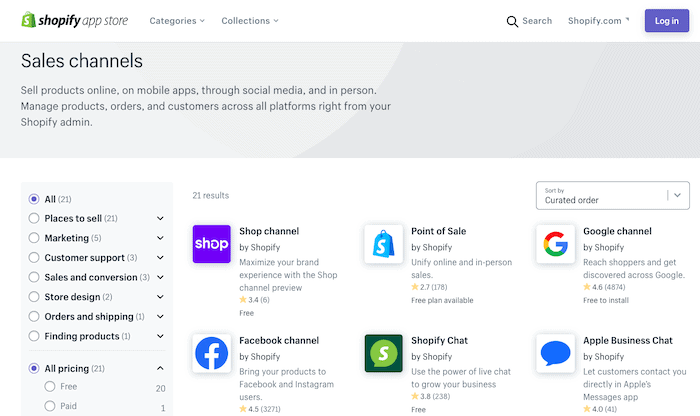
The biggest perk of all this? You maintain and manage your sales from one place (your Shopify backend).
I have to say that some channels work smoother than others. For example, with the Instagram integration, many users have had issues getting their store validated.
Shopify Online Marketing features
As any other store builder, Shopify provides you with a bunch of tools to help you implement your Shopify marketing strategy.
Discount codes can be added to your Shopify store easily. They are very flexible as you can set codes for fixed amounts, percentages, free shipping or even “buy one get one free” promotions.
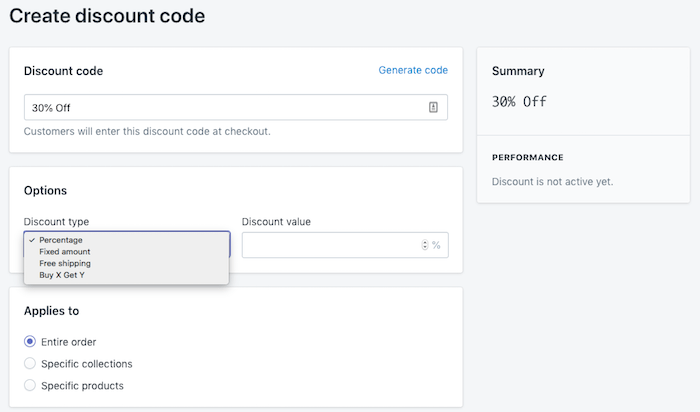
You can also promote gift cards for your online store (a feature that was recently made available on all plans, excluding Shopify Lite).
Shopify doesn’t come with a loyalty program (e.g. collecting points with each purchase). If you’d like to implement this, getting an app (like Smile.io or S Loyalty) is your easiest and cheapest option.
Shopify also has its own email marketing tool that will allow you to send emails from its platform. However, at this time, it’s somewhat simple and other alternatives could be a better fit for you.
Abandoned cart recovery
In the world of online shopping, the average abandoned cart rate seems to be well above 60%. In other words, 2 out of every 3 users won’t actually finish their purchase – sobering, isn’t it?
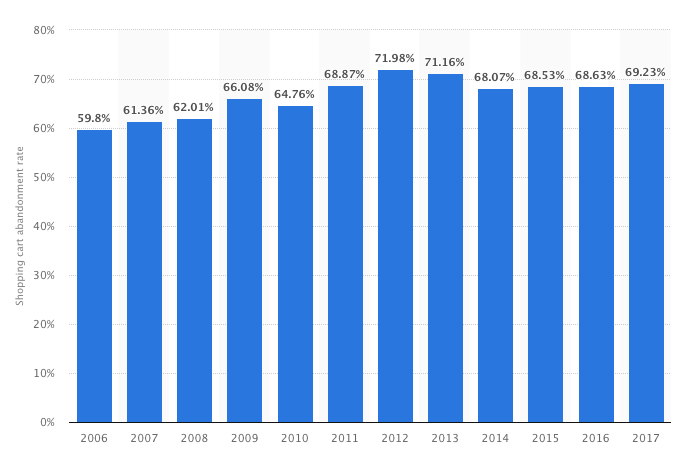
That’s where the abandoned cart recovery tool can help you. This is a feature that allows you to interact with those who never placed the order, in an effort to gain them back.
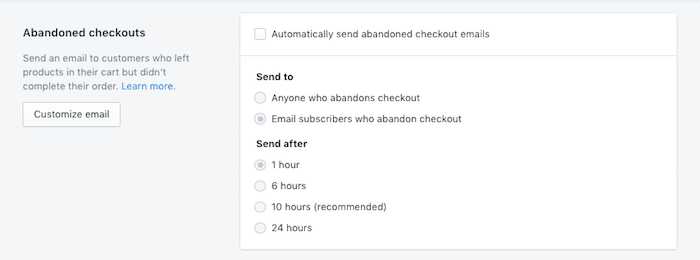
For example, you can set Shopify to send automated emails with a discount code to those users that never finished the purchase process – assuming you know their email addresses.
I have to say that whilst the system is easy to set up, I find it a bit limited. Other options like popups or banners would be nice to have.
Shopify Email recently added a whole suite of automation templates to help you stay connected with customers. Beyond abandoned cart emails, you can set up a welcome series, a post-purchase upsell, thank you emails and more.
Sidenote: Shopify now includes this feature in all three main plans, including Basic Shopify.
Sell face-to-face with Shopify – PoS
Yes, I know, the whole point of getting Shopify is to sell your goods and services online. But with Shopify, store owners can also sell the old way, face-to-face.
If you want to sell offline, it’s possible to integrate Shopify’s PoS (point of sale) with your physical sales channel – even if you are on the go.
The great thing about it is that it’ll be completely integrated with your Shopify backend, so your reporting, inventory management, prices, etc are automatically synced.
You can also integrate the POS with extensions such as full-screen apps and product recommendations, to increase cross-selling opportunities and enhance the customer purchasing experience.
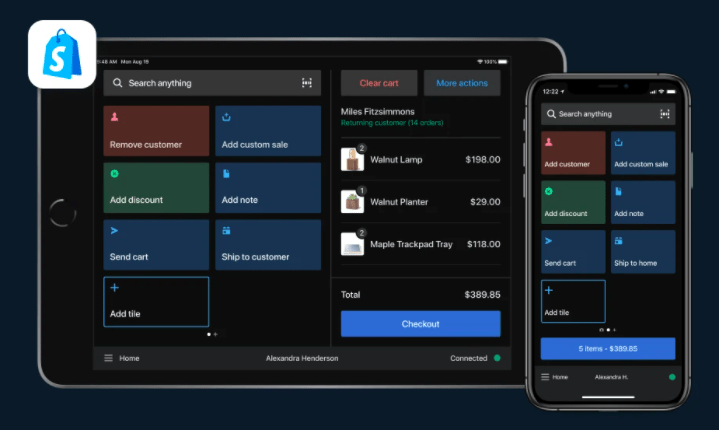
You can start small, by selling items using the Shopify PoS app (e.g. using your smartphone or tablet) and accepting payments. You won’t need anything else, and the Shopify POS Lite subscription is free on all Shopify plans. Pretty useful to test physical store ideas.
But if you are planning to sell offline a lot, you may want to look into buying PoS hardware to make your life easier. For example, Shopify offers a couple of card readers that you can connect to your smartphone or tablet, starting from $29.
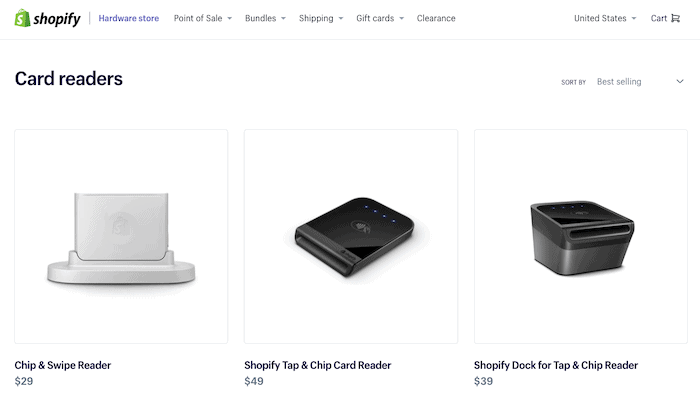
Other accessories such as barcode scanners, receipt printers and cash drawers are also available.
Sidenote: If you are based outside the US, Canada or the UK, you can’t purchase (PoS) hardware from Shopify. However, you can get a third-party device.
In light of the pandemic, Shopify also introduced the local pickup / curbside pickup feature, which allows customers to purchase products online and collect them at a nearby location. If you have the Shopify POS Pro plan (free on Shopify Plus plans, or on lower plans for an additional $89 USD/month per location), you can even prepare and manage pickup orders directly from within the POS app.
Shopify SEO – Any good?
I get dozens of SEO questions a month. And a lot of them are users wanting to know if they’ll ‘conquer’ the first organic positions with this website builder or that other one.
Let me say that most of the time, SEO ranking issues are related to poor optimization jobs (e.g. bad content) and not Shopify (or other tools’) issues. However, Shopify has a few SEO drawbacks you should be aware of:
- Shopify URL structure isn’t 100% customizable. For example, product pages will always include ‘/products/’ in their URL – this can’t be changed.
- Shopify doesn’t make it easy to create sub-categories, which can be an SEO pain for some.
- Although you can create non-ecommerce content easily, it can be a bit limited (e.g. not possible to add widgets or maps). Sometimes, you may need a bit more (content) flexibility to support your overall SEO strategy.
However, despite the above-mentioned pitfalls, I would say that Shopify’s SEO is good and intuitive. For example, customizing most of your SEO parameters (e.g. title tags, descriptions, image alt text, etc) is easy.
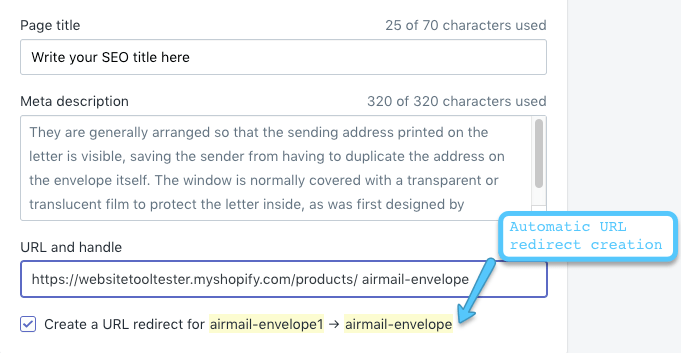
I really like the redirect system they have in place. When you change a URL, Shopify will automatically create an optional redirect from the old URL to the new one – so you don’t generate 404 errors.
For more information about Shopify’s SEO, please check this detailed Shopify SEO review.
Shopify blog and content generation
Sure, Shopify comes with a blog you can use for your content marketing strategy. It even has a lot of blogging features you’ll need. However, it can feel limited – especially when compared to platforms like Weebly or WordPress.
From their blog I like that:
- It’s fully integrated with your store site
- Tags are easy to set
- You can have more than 1 author
- SEO parameters are customizable
But I’d like to see them improve on the following:
- The editor feels a bit old and doesn’t come with many elements (e.g. galleries)
- Blog layouts are not as flexible as they could be
- It doesn’t have categories, you are forced to use tags
- Tricky to add commenting systems like Disqus
- No related posts feature
- Not possible to embed products in blog posts – a big downer for me
Sidenote: Some of these missing features can be added by installing an app from the Shopify App Store.
Despite all this, I have to acknowledge that Shopify’s approach to blogging is a way better solution than what BigCommerce or Volusion offer and should be good enough for most ecommerce sites.
But of course you could always put your blog on a subdomain and let it run through an external platform. But that comes with its own set of challenges.
In the past Shopify’s page editor felt limited, but now it’s possible to add many different page elements. Each theme will vary, but even free themes allow you to add content like featured products, slideshows, contact forms and more.
Reporting and Analytics
Shopify reports are OK, good or amazing, depending on what plan you have. I am not a big fan of this and I believe everyone should be given access to all the data – as Shopify competitor BigCommerce does.
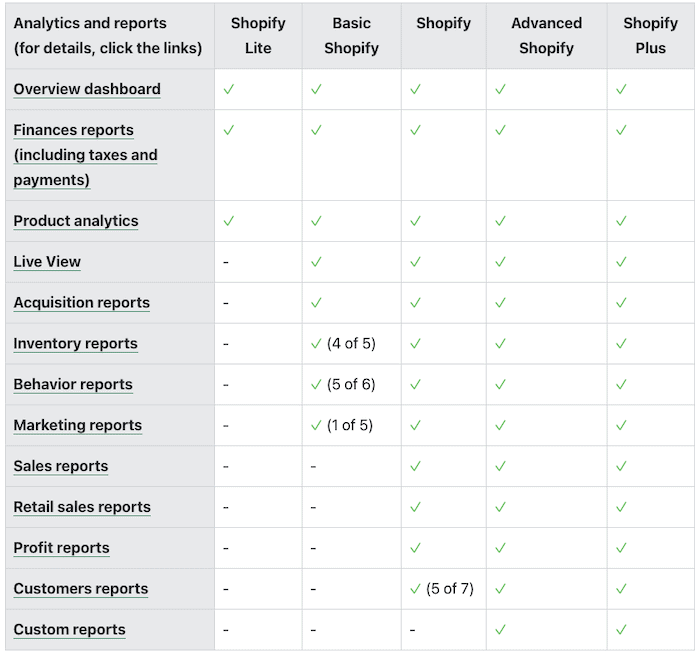
The Basic Shopify plan reports are limited to:
- An overview of a few key metrics (e.g. sales, user sessions, orders, etc)
- Real-time reports
- Finance reports (e.g. sales, taxes, payments, etc.)
- Acquisition reports – general information about how you got your visitors
- Inventory reports (e.g. month end snapshot, % of inventory sold)
- Some behavior reports (e.g. conversion rates, check out rates, etc.)
- Analytics by marketing campaign linked to a UTM campaign (e.g. a newsletter)
The ‘Shopify’ plan comes with a couple of nice perks:
- Sales report – connects customer metrics with sales metrics
- Retail sales report – for POS sales
- Profit reports – including profit by product, variant, and POS location, as well as the effect of discounts and refunds
- Customer report – to find out things like returning customers or customers by country
Finally, if you have the Advanced Shopify plan or Shopify Plus, you’ll be able to create custom reports. Using their filters you can dig as deep as you need into your data.
Connecting Google Analytics (with conversion tracking) is also possible. So, you may not even need Shopify’s reports at all – although not all the Shopify Reports data can be found in Google Analytics.
Additionally, there are dozens of reporting apps you can get from the Shopify App Store – personally, I’ve never used any of these apps, so I can’t comment on their quality or features.
Shopify App Store
Shopify has an app market where you can find extensions (for adding extra functionality) for your online store. These are similar to the ones you can add to your smartphone.
Many ecommerce solutions (e.g. BigCommerce, Wix, Weebly) have their own version of this Shopify App Store. But the main difference is that Shopify has an insane amount of apps. From email marketing integrations to dropshipping connections, you name it – Shopify will most likely have it.
These can certainly save you a lot of money and time – especially compared to custom-developed solutions.
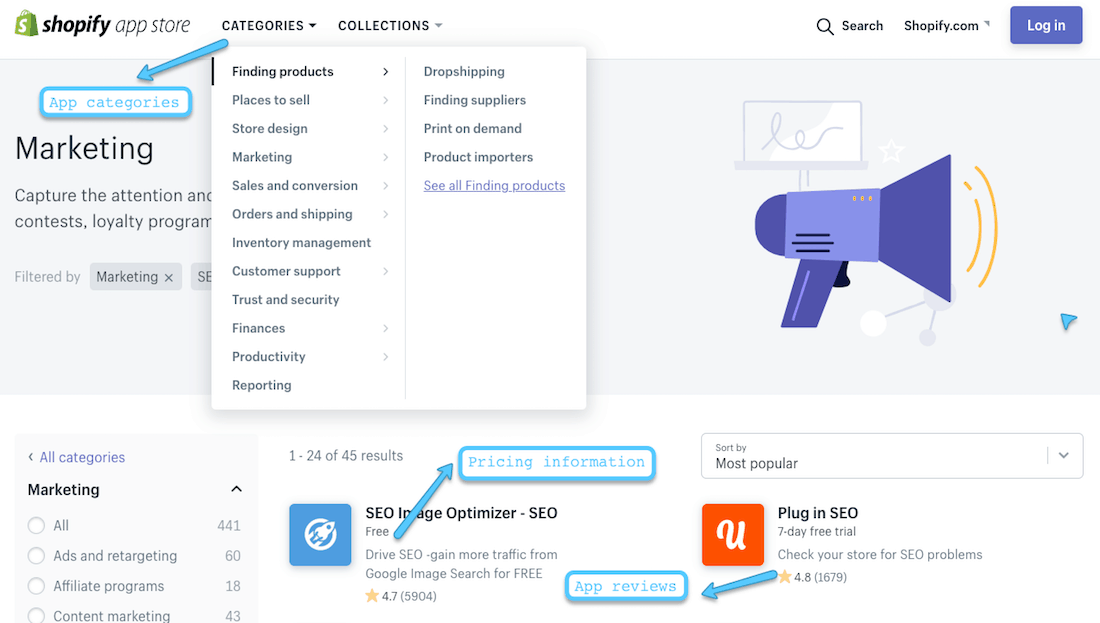
There are a bunch of free apps (over a thousand), but many others are paid apps. And the app quality… well, it really depends on the app. Luckily, you can read reviews before installing them.
Some of the apps are even developed by Shopify themselves. For example, the digital downloads extension or the Facebook, Google and Amazon integrations.
The not so cool thing is that it can get expensive. For example, if you need 2 or 3 paid apps, you might need to pay $50 or $60 extra a month – not every store owner can afford this.
Shopify Support & Experts
You can contact Shopify 24-hour support team via email, phone or live chat. One of their Support Gurus will take care of your question – yup, that’s their real job title.
In general, my experience with Shopify support has been good. They are (relatively) fast and helpful. But this depends a lot on the type of question (e.g. how technical it is) and your luck with the support agent.
We also tested their support on a broader scale, comparing it with 9 other website builders and ecommerce platforms. Shopify came out 2nd, thanks to both the quality of their answers and their useful knowledge base. In this test, Shopify’s rival BigCommerce only made it to the 5th place.
In my opinion, support is one of the biggest advantages of using Shopify (or similar solutions) over a traditional CMS (like WooCommerce). Being able to ask an expert when you’re stuck can save loads of hassle.
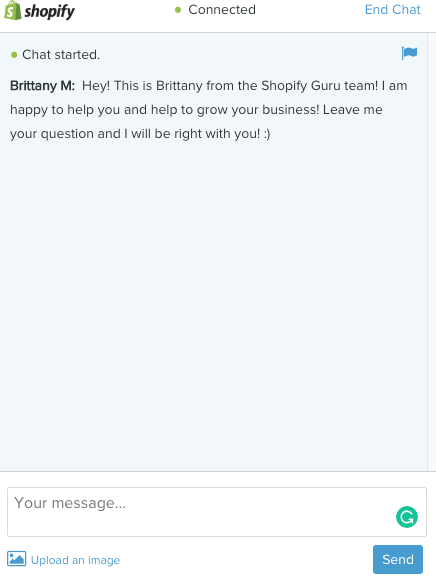
Personally, I don’t want to contact support for each tiny question I have, as that’d be very unproductive. Luckily, Shopify has many detailed tutorials and guides, so check them out first if you have a question – they may solve your doubt instantly.
And if you need professional help with your store, Shopify has a directory of (certified) Experts you can contact – but make sure you read the experts’ reviews before hiring one. Another option is Storetasker. There you can easily submit your custom project (e.g. a complete store setup or just some design tweaks) and have their vetted Shopify Experts submit a quote for your job.
Security and backups
Being hacked is not fun, it can put your business under serious pressure. So I don’t have to tell you how important it is to keep your store safe.
Unlike WordPress and similar CMSs, Shopify takes care of updates and security matters in the background – and I love this. I’ve wasted many hours trying to fix WordPress issues after plugin updates that went wrong.
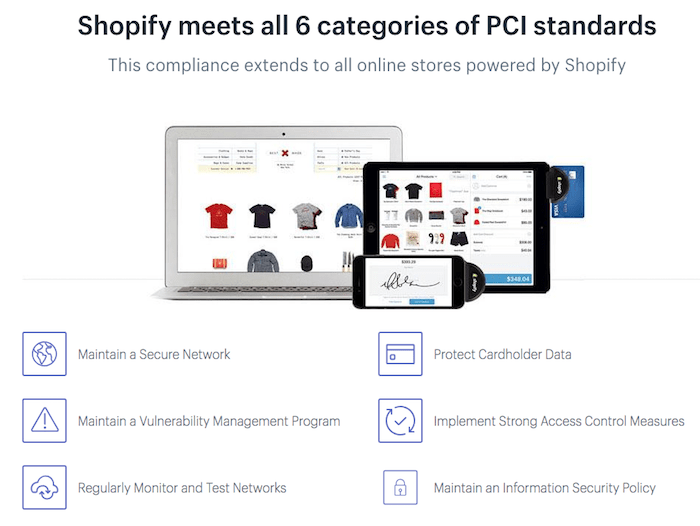
Shopify’s system runs on Level 1 PCI compliant servers – mandatory for accepting credit card payments. SSL encryption (at 256-bit) is enabled for every Shopify store too – to keep your visitors’ data safe.
At Shopify, they do have a backup system in place. In desperate times, they can restore your online shop. But this is not an official service, they advise you to keep regular backups of your site by exporting a series of CSV files – I don’t like this solution as it’s time-consuming.
That’s why adding a more advanced backup solution from the Shopify App Store (e.g. Rewind) may be wise – it’s a lifesaver if you delete content (e.g. products) by mistake.
In short, to keep your store protected, you only need to do regular backups and have a strong admin password.
Shopify Review Conclusion: Is this tool for you?
Shopify is one of my favorite solutions to create online stores with.
It has many cool features and advantages, but also a couple of downsides you should consider before deciding. Keep on reading to find out.
What I like about Shopify
Shopify has many advantages and cool features, but here are my favorite ones:
- Adding products, as well as managing payment, shipping options and orders is absolutely painless.
- Their layouts (templates) can be modified to a large degree without any programming knowledge.
- Shopify can help you with your content marketing too as it comes with a blog and more. Although with some limitations.
- It’s possible to change your store’s look and add extra-functionality by installing new templates and apps in seconds.
- If you are a programmer (or hire one), you can have complete control over your online store customization.
- Having official 24-hour support is something I value a lot.
- No matter how fast your business grows, Shopify can accommodate any size of ecommerce project – whether it’s small, big or colossal
- If you are into dropshipping, Shopify integrates with several apps/providers (read guide).
- A nice perk is that you can sell offline with their PoS solution.
To sum up, I like Shopify (and you will probably too) because it’s straightforward. At the same time you can develop custom solutions if needed. Additionally, I don’t have to worry that my stores will get too big for Shopify; their system will grow with them.
Shopify’s flaws
But yes, there are also some things that could bother you. Let’s list them:
- I think Shopify Prices are fair, but you’ll definitely need a budget as it starts at $39 per month. Alternatives like Ecwid can work out to be a lot cheaper.
- I am not a big fan of their extra transaction fees if you don’t use Shopify Payments – they can add up quickly.
- Setting up multilingual stores isn’t easy (nor cheap). A good solution for you could be this (paid) app. It looks like their new multilingual/multicurrency solution, Shopify Markets, will improve this, but carries an extra cost of up to 6.5% per transaction (Markets Pro).
- Some of the coolest features are only included in the higher plans (e.g. the advanced report builder, third-party shipping rates).
- As you can read above, it has a couple of SEO issues (more information). If you sell handmade or vintage goods, you might find that attracting customers is easier on a marketplace like Etsy (read more in our Shopify vs Etsy comparison).
Our recommendation: before going “big,” consider picking the “Basic” plan ($29/month). If you need more features you can always upgrade. WordPress users can integrate Shopify Starter for only $5/month.
OK, this was a long article, but I hope it helped you clarify what to expect from Shopify. But if you are still not sure if Shopify is right for you, leave me a comment and I’ll try to help you decide.
Try Shopify 3 days for free (no credit card needed)
Is Shopify the right choice for you?
- Recommended If
- Not Recommended If
you want to sell physical and digital goods
you require customer logins
you need an easy way to integrate third party ecommerce features and apps
you would like to have full control of the templates
you need a wide range of payment options
Shopify Example Sites
Shopify User Reviews
Read MoreFAQ
There are two kinds of fees: one that Shopify charges and another that you have to pay to the payment gateway processor you use (e.g. PayPal or credit card payment processors such as Stripe or Authorize.net).
Depending on your pricing tier, Shopify would charge somewhere between 0,5% and 2% plus the payment processor’s fee (typically 3% + 30¢). You can avoid Shopify’s fees by using the Shopify Payments gateway (only available in USA, UK, Ireland, Canada and a few other countries).
Yes. You can sell files with Shopify. Find more information here.
Yes, you can always change your plan type. An upgrade or downgrade will initiate a new billing cycle and close the current one. Existing funds will be credited to your new plan.
To cancel your online store, go to Settings > Account page. Select the “Close my Store” option.
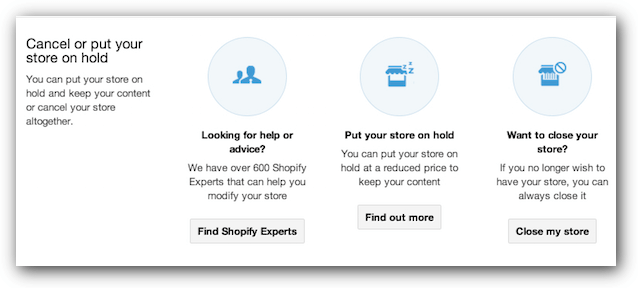
Shopify has a free app for Android and iOS that will let you create and manage your online store on the go. Among other things you can: process orders, manage products, add and contact customers, change your template and check the performance of your online store.
For more information, please check this page.
Yes, Shopify is a legit company. They are publicly traded at the NYSE. So yes, it’s safe to do business with them. You can test Shopify for free. However, once you upgrade, do keep in mind that, unlike most other site builders, they don’t offer a money-back guarantee.
Another thing to be aware of is that there is a small number of Shopify stores that are run by scammers. And although Shopify is closing down these online shops regularly, they can’t catch every fraudster immediately.
The backup process that Shopify provides is not an easy undertaking as it’s a manual process that involves a lot of steps.
In their App Store you can also find automated solutions: one is Rewind, which has pretty positive ratings and starts at $5 per month. Learn more here.
Yes, there are a few options to pause your Shopify storefront, provided you are eligible (i.e. you are least 60 days past your free trial period, and are not on Shopify Plus):
- Pause and build – this lets you ‘freeze’ and continue to work on your store for a reduced subscription fee. Customers can still view your products, but can’t make purchases.
- Pause – this allows you to ‘close’ your store for three months and pay no subscription fee. You won’t be able to sell or make changes to your store during this time.
As part of Shopify’s Online Store 2.0 launch, they recently introduced requirements for all new themes to meet a minimum accessibility score. Stores using older themes can make their sites accessible with the help of third party apps (e.g. by enabling visitors to use text readers, and adjust font sizes, colors etc); however there is no inbuilt functionality to enable these features.
Shopify isn’t just a tool for building an ecommerce store, they could also give you a small business loan!
Unlike traditional lenders, Shopify Capital doesn’t require credit checks. Instead, they base eligibility on the sales history of your Shopify store. You pay back the loan by giving a set percentage of your daily sales.
Shopify Capital is available to store owners who use Shopify Payments and are located in select regions, currently the United States, the United Kingdom, and Canada.
Shopify Collabs is a tool that helps brands on Shopify form partnerships with influencers.
The platform offers features such as a recruitment portal where store owners can find and reach out to potential collaborators. Then, you can send them gifts or samples to promote on their social channels.
Shopify Collabs also allows brands to create an affiliate marketing program, offering links and discount codes that influencers can use to promote your products.
- Shopify Uptime & Server Response Time
- Shopify Page Speed
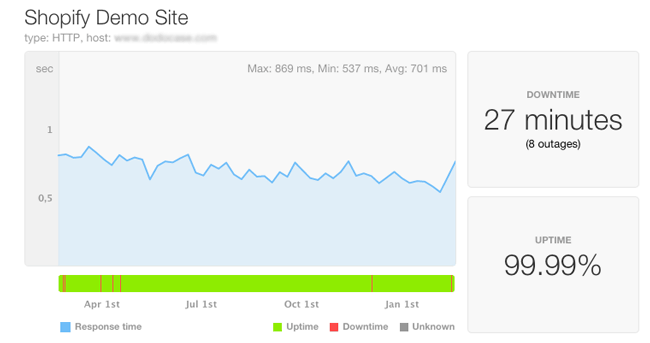
This image shows you the website availability of our Shopify demo website during the last year. Ideally the uptime is 100% with zero outages. In ecommerce you would generally want to have an uptime of 99.95% or higher as every minute your website is down will cost you money. Shopify is as good as it gets with an unparalleled 99.99%!
Response time: nobody likes a slow website. Your online store generally should have an average server response time of less than 800ms or it can feel slow, however, the overall experience also depends on the page speed (see next tab).
Shopify Alternatives
BigCommerce and Shopify are relatively equal. But for some, even their small differences can be crucial: BigCommerce is in the lead when it comes to SEO. This added flexibility can be valuable in competitive markets. Also, unlike Shopify, BigCommerce doesn’t charge any transaction fees. However, they will put you into a higher pricing plan as you hit certain thresholds in your sales. Check out our Shopify vs BigCommerce comparison or full BigCommerce review for more details.
WooCommerce should be your preferred choice if you’re not afraid of terms like FTP, MySQL and plugin updates as you’ll have to install it on your own WordPress site. The main reason to choose it over Shopify, from our point of view, is if you need a multilingual website and you need a lot of flexibility. In this article, we’ve compared both Shopify and WooCommerce.
Wix Ecommerce plays in a different league as it’s made for smaller stores. So if you primarily want to have a great looking website with a blog and an added shopping cart, Wix is for you. As it’s geared towards beginners, adding content and managing your store is a lot easier than with Shopify. It’s not to be underestimated as it comes with customer accounts, lots of payment methods and the ability to sell digital products. Read our comparison of Shopify vs Wix here.
Still not sure what store builder you should use?
> Our comprehensive guide to the best ecommerce website builder will help you decide.
> Find even more Shopify alternatives here.
> Or let our smart finder decide for you in 2 minutes.
We keep our content up to date
01 Feb 2024 - Changes to free trial
17 Jan 2024 - Shopify Markets update
18 Jul 2023 - General updates, new features
25 Jan 2023 - Price updates
15 Dec 2022 - Badge added
21 Oct 2022 - Speed test data updated
08 Mar 2022 - Small update
28 Feb 2022 - Reflects introduction of Online Store 2.0 and Shopify Markets
22 Feb 2022 - Updated FAQs
02 Jul 2021 - Update of multilingual feature
18 Jun 2021 - Mention of Shop Pay
31 Mar 2021 - General update, new features added
20 Feb 2019 – Update in templates
23 Oct 2018 – Adding the results of our support test
04 Oct 2018 – Minor updates
28 Aug 2018 – General update and new format
16 Jul 2018 – Mention of Shopify Exchange
07 May 2018 – Information about Backup solutions
20 Apr 2018 – Further details in alternatives
28 Feb 2018 – Changes in the uptime section
12 Jan 2018 – Added Shopify video script
09 Aug 2017 – Mobile phone app information added
31 Jul 2017 – General information update
21 Jul 2017 – New feature: checkout on your own domain
17 Jan 2017 – Shopify’s new templates provide better design options.
17 Nov 2016 – Update in pros & cons (SEO)
09 Aug 2016 – Shopify payments: update in supported countries.
21 Feb 2016 – New pricing – Starter plan discontinued
21 Feb 2016 – FAQ update (WordPress)
03 Feb 2016 – Use case section added
08 Sep 2015 – Uptime, response time and page speed tests added
10 Mar 2015 – Android app available and multilingual app added
26 Nov 2014 – Updated text in product variants
28 Mar 2014 – Initial review of the Shopify online shop
THE BEHIND THE SCENES OF THIS REVIEW
This article has been written and researched following a precise methodology.
Our methodology






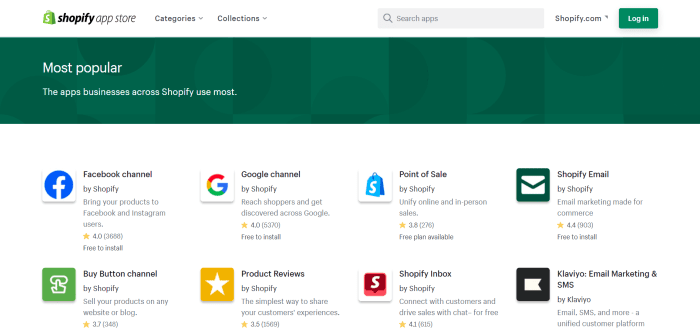
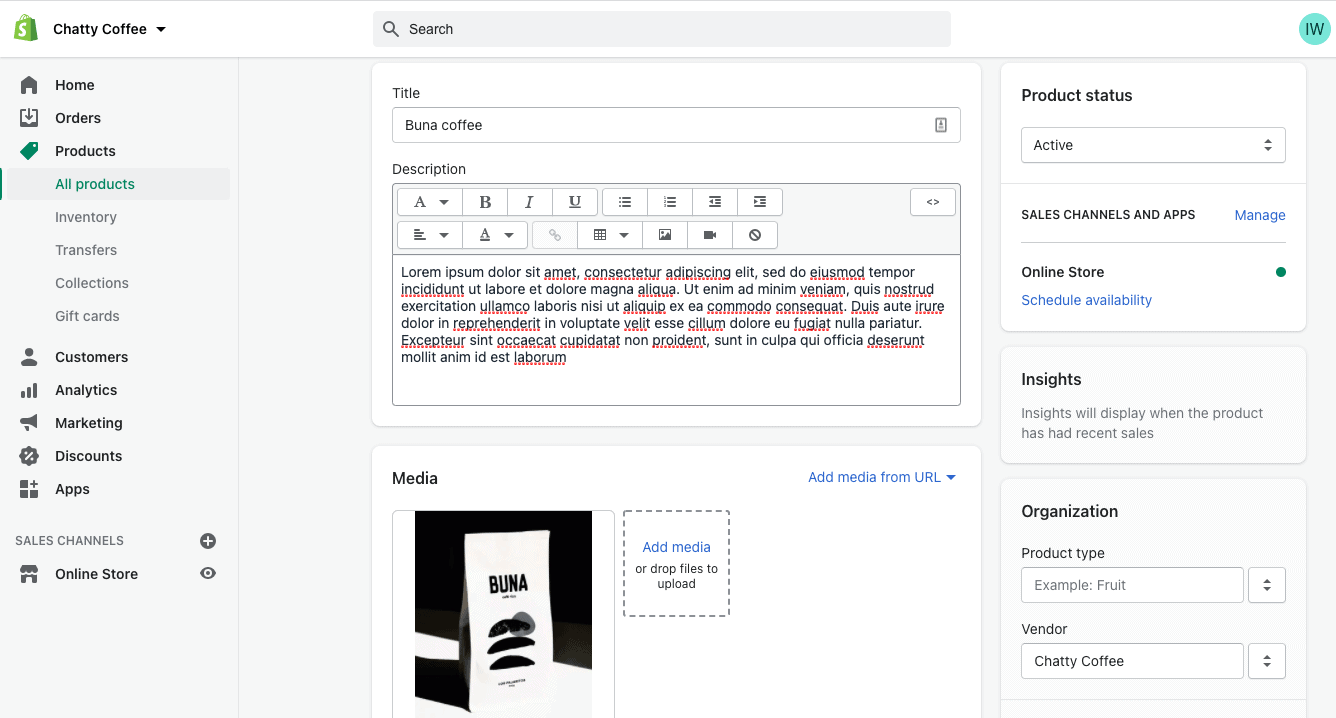
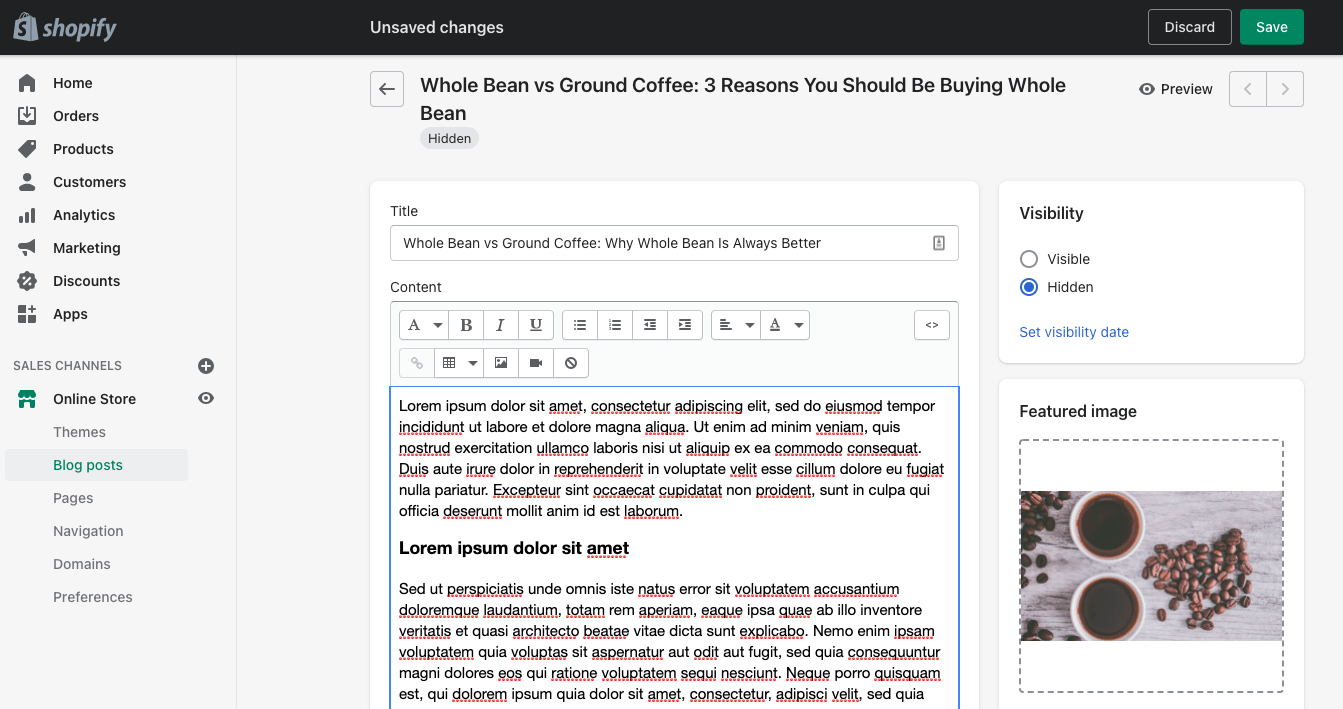
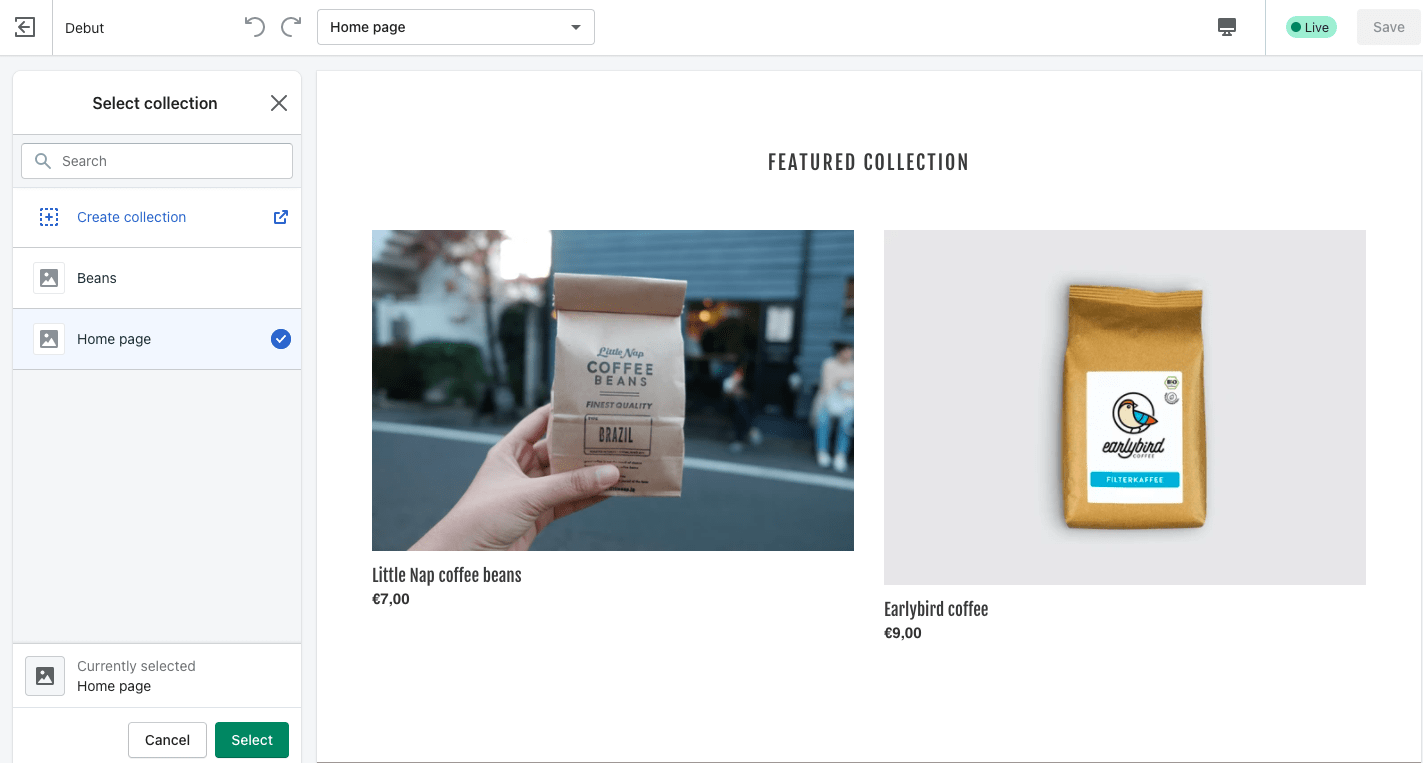
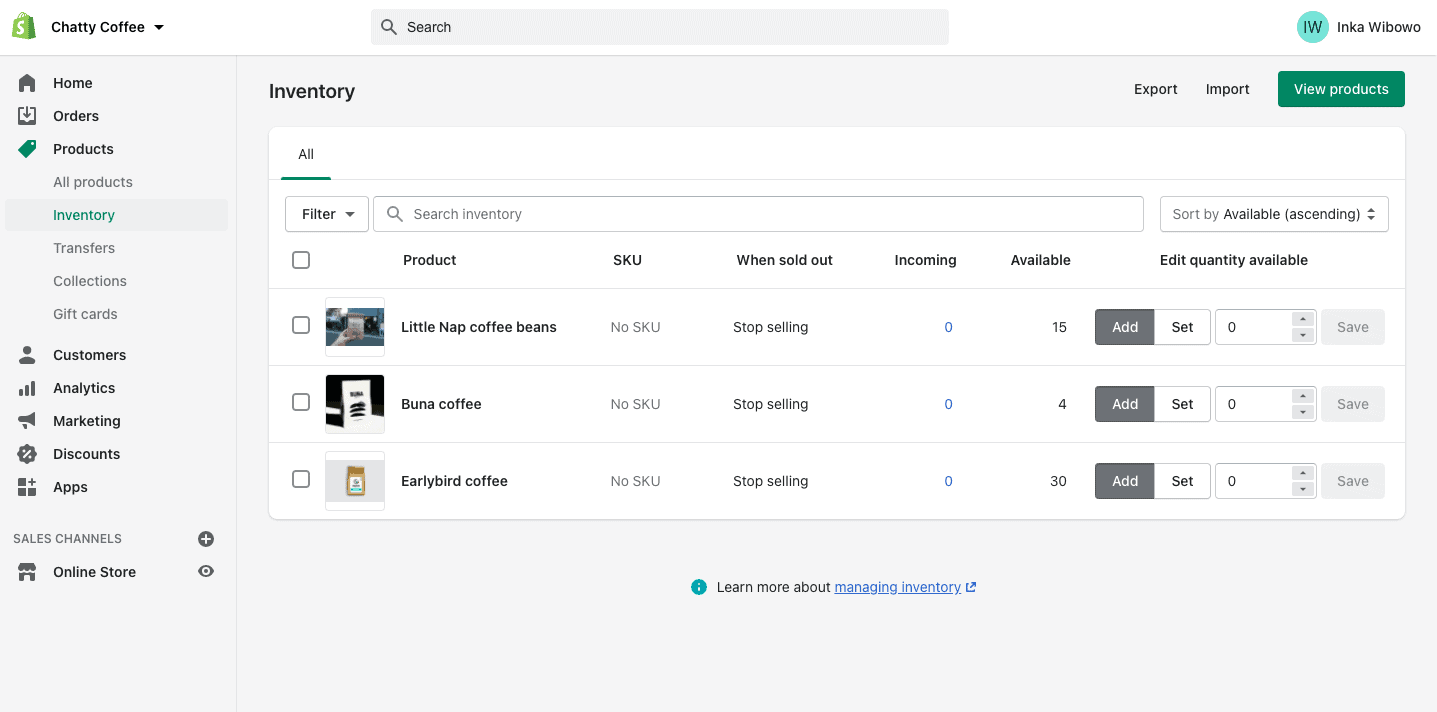
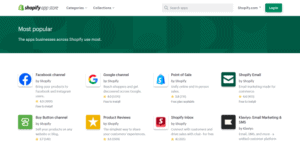
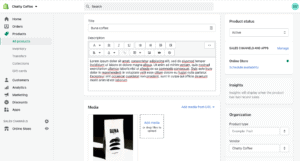
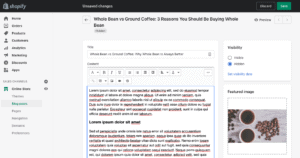
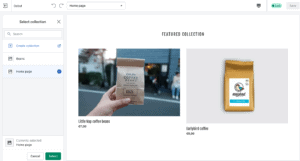
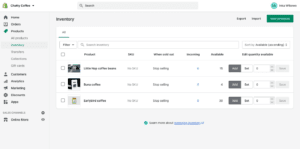








Comments